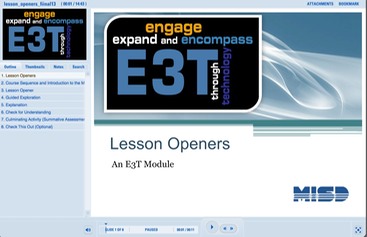The opening activity should be brief, usually 15-20 minutes in length. Its role is to activate prior knowledge, engage the student and to establish a purpose for learning. Consider it the "hook" used to entice students to dive deeper into the content.

A good lesson opener helps students bring forward the information they have already mastered on the topic and it helps students set a personal path to the new learning ahead.
Lesson openers that are novel, engaging, relevant and contain a personal connection help students' focus their attention on the work ahead.
Lesson Opener Ideas and Resources :
Teacher's Domain:
http://www.teachersdomain.org/
Teachers' Domain is a extensive library of free digital media resources produced by public television, designed for classroom use and professional development.
Teachers First
http://www.teachersfirst.com/index.cfm
TeachersFirst is a rich collection of lessons, units, and web resources designed to save teachers time by delivering just what they need in a practical, user-friendly, and ad-free format. We offer our own professional and classroom-ready content along with thousands of reviewed web resources, including practical ideas for classroom use and safe classroom use of Web 2.0. Busy teachers, parents, and students can find resources using our subject/grade level search, keyword search, or extensive menus.
PBS Learning Media
PBS Learning Media
http://www.pbslearningmedia.org
http://www.pbs.org/teachers/socialstudies/
Free high quality media spanning multiple K-12 subjects.
Padlet
Use Padlet to gather students’ opinion on a question related to the upcoming content.
ELA and Social Studies Resources
Digital History:
http://www.digitalhistory.uh.edu/
This site contains primary source documents and historical digital images.
American Rhetoric:
http://www.americanrhetoric.com/
Database of and index to 5000+ full text, audio and video versions of public speeches, sermons, legal proceedings, lectures, debates, interviews, other recorded media events, and a declaration or two
Science Resources
The Wild Classroom:
http://www.thewildclassroom.com/
This site provides teachers with quality videos for use in their Biology classrooms.
Alien Earth:
http://www.alienearths.org/online/general/activities.php
Web Activities that look at the nature of life and the possibility for life on other planets.
Why Files:
Science in the News.
PhET
http://phet.colorado.edu/index.php
Fun, interactive, research-based simulations of physical phenomena from the PhET project at the University of Colorado.
Math Resources
How am I Ever Going to Use this Stuff?
http://www.micron.com/k12/math/
Math in Daily Life
http://www.learner.org/interactives/dailymath/
Video Clips:
Websites such as YouTube and TeacherTube offer a wide variety of video clips that can be used in the classroom. Choose your video carefully. Sometimes less is more. Showing a short clip and then allowing time for discussion or reflection works well.
iTunes Podcasts: (check the link to educational podcasts) http://www.apple.com/itunes/podcasts/
TedEd Lessons Worth Sharing: http://ed.ted.com/
Discovery News: http://news.discovery.com/
National Geographic Channel http://channel.nationalgeographic.com/
Cable in the Classroom: http://www.ciconline.org/ProgrammingAndResources
Flocabulary – Library of songs, videos and activities for K-12 online learning.
Simulation/Activity:
There are numerous web-based simulations on a variety of topics. Use words such as “simulation”, “interactive” and “educational” along with your topic of study to search for activities that may work well as your entry event. The possibilities are endless so put Google to use for you and find just the right simulation for your lesson. Simulations do not have to use technology. Set up a court room in your classroom, stage a debate or act out an event that correlates with your PBL unit.
Song/Artwork:
Use iTunes to download music from a certain time period or popular music that supports your lesson. Another great idea is to rewrite the lyrics of a popular song to correspond with your project objectives. There are a number of songs/videos like this on YouTube and better yet, some even have students performing the songs. There are great resources online and in books which portray beautiful works of art to spark discussion and curiosity in your classroom.
- Metropolitan Museum of Art: http://www.metmuseum.org/
- Detroit Institute of Arts: http://www.dia.org/
Piece of Mock or Real Correspondence:
If you donʼt have connections to have a real person write to your classroom, it is okay to pretend. Go online and find the official logos of a company or organization and write your own letter challenging your students to solve a problem or come up with a plan for the community. Make it look official and professional and your students will be just as engaged as if it were the real thing. Pretend you are the CEO of Ford Motor Company and ask your students to design a car of the future that doesnʼt rely on fossil fuels.
Lively Discussion:
Share something from the news/current events or a situation that happened at school and allow time for students to openly discuss the topic. Allow them the freedom to express their ideas and accept all viewpoints. Once the excitement builds and youʼve captured their attention transition to your PBL unit and use their ideas from this discussion to enhance your project.
E3T Module
